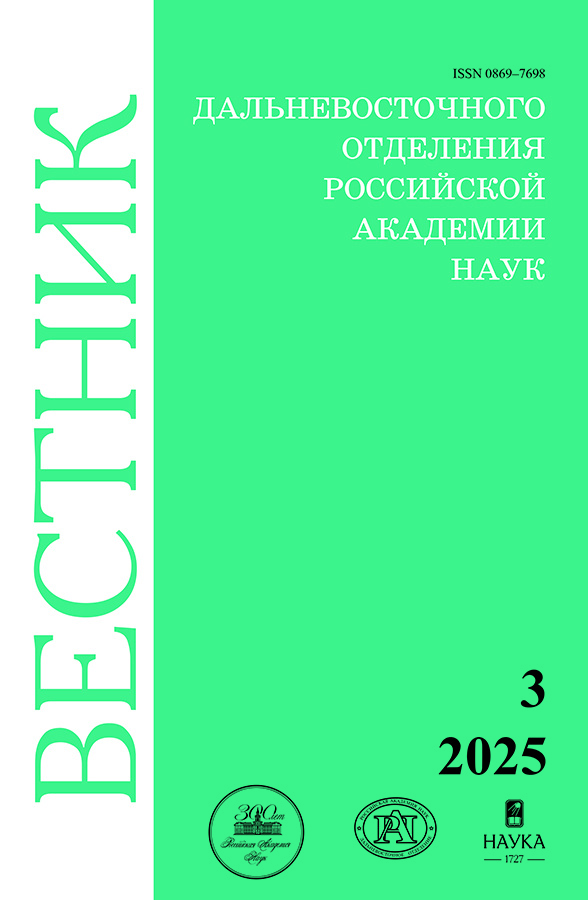The Sugdzhar gold deposit system of the Amur gold-bearing province
- Authors: Stepanov V.A.1, Melnikov A.V.2
-
Affiliations:
- Research Geotechnological Center, FEB RAS
- Institute of Geology and Natural Management, FEB RAS
- Issue: No 3 (2025)
- Pages: 5-15
- Section: Earth and Environment Sciences
- URL: https://permmedjournal.ru/0869-7698/article/view/688919
- DOI: https://doi.org/10.31857/S0869769825030015
- EDN: https://elibrary.ru/EBXEZN
- ID: 688919
Cite item
Full Text
Abstract
The description of the Sugdzhar gold-scattering system (ZRS) of the ore-placer node of the same name in the North-Stanovoy metallogenic zone of the Amur province is given. The ZRS is confined to an intrusive dome uplift composed of gneisses and crystal shales of the Archean, partially overlain by volcanites of the Early Cretaceous and ruptured granitoid intrusions of the Middle-Late Jurassic and Early Cretaceous age. It is shown that placers and manifestations of gold are concentrated in the exocontact zone of the Toksko-Sivakan intrusion of granodiorites and syenites of the Toksko-Sivakan complex of the Early Cretaceous. It has been established that the main typomorphic features of placer gold are the small size of gold pieces, low sample (727–829‰) and the presence of dendritic crystals. The sources of placer formation are manifestations of ore gold, represented by quartz veins and breccia zones cemented with quartz with free native gold of low (689–827‰) sample. Due to the small parameters of ore bodies and low gold contents, the known gold mineralization is not adequate for rich placers. It is assumed that there is an additional, previously unidentified source of placer formation located within the Toksko-Sivakan granitoid intrusion.
Full Text
About the authors
Vitaly A. Stepanov
Research Geotechnological Center, FEB RAS
Author for correspondence.
Email: vitstepanov@yandex.ru
ORCID iD: 0000-0002-7028-3662
Doctor of Sciences in Geology and Mineralogy, Chief Researcher, Professor
Russian Federation, Petropavlovsk-KamchatskyAnton V. Melnikov
Institute of Geology and Natural Management, FEB RAS
Email: melnikov_anton1972@mail.ru
ORCID iD: 0000-0002-5193-2938
Candidate of Sciences in Geology and Mineralogy, Leading Researcher
Russian Federation, BlagoveshchenskReferences
- Petruk N.N., Belikova T.V., Derbeko I.M. Geologicheskaya karta Amurskoj oblasti. Masshtab 1:500 000. Blagoveshhensk: FGUGP “Amurgeologiya”; 2001. 236 s. (In Russ.).
- Neronskij G.I. Tipomorfizm zolota mestorozhdenij Priamur`ya. Blagoveshhensk: AmurNCz; 1998. 320 s. (In Russ.).
- Petrovskaya N.V. Samorodnoe zoloto. Moscow: Nauka; 1973. 347 s. (In Russ.).
- Stepanov V.A., Shishakova L.N. Kubakinskoe zoloto-serebryanoe mestorozhdenie. Vladivostok: Dal’nauka; 1994. 198 s. (In Russ.).
- Neronskij G.I., Dobraya V.T. Geoximicheskie osobennosti samorodnogo zolota iz rossy`pej Sugdzharskogo rajona. In: Geoximiya i metody` issledovaniya mineral’nogo sy`r`ya Dal’nego Vostoka. Vladivostok: DVNCz; 1975. S. 85–92. (In Russ.).
- Mel’nikov A.V., Stepanov V.A. Sugdzharskij rudno-rossy`pnoj uzel Priamurskoj zolotonosnoj provincii. Otechestvennaya Geologiya. 2017:(2):42–50. (In Russ.).
- Groves D.I., Santosh M. The giant Jiaodong gold province: the key to a unified model for orogenic gold deposits? Geoscience Frontiers. 2016;7:409–417.
- Li L., Santosh M., Li S.R. The “Jiaodong-type” gold deposits: Characteristics, origin and prospecting. Ore Geology Reviews. 2015;65:589–611.
Supplementary files










